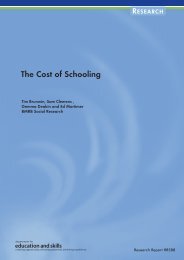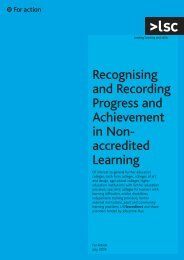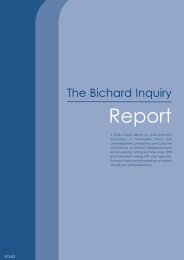Faiths and further education - Church of England
Faiths and further education - Church of England
Faiths and further education - Church of England
- No tags were found...
Create successful ePaper yourself
Turn your PDF publications into a flip-book with our unique Google optimized e-Paper software.
<strong>Faiths</strong> <strong>and</strong> Further Education:A H<strong>and</strong>bookFunding21As is clear from the models described above, a variety <strong>of</strong> fundingpossibilities exists, ranging from fully funded by the college(sometimes with smaller colleges partially defrayed by teachinghours) to part-funded by a church or ecumenical body (sometimesin the form <strong>of</strong> a minister’s post with a job description allocating,say, 50 per cent <strong>of</strong> the time to the local college).“We started with an all-voluntary team. But eventuallyit was the principal who wanted to introduce paidsessions. He thought he would get more continuity<strong>and</strong> commitment to the college.” (Chaplain)22Combination funding is the commonest funding model forchaplaincy teams, particularly where lay volunteers (for example,former teachers or FE lecturers) are willing to contribute time.Asmall number <strong>of</strong> posts are funded by ecumenical organisations (forexample, a local ecumenical partnership, <strong>Church</strong>es Togetherinitiative, or a local <strong>Church</strong> Trust) which may have <strong>education</strong> as one<strong>of</strong> its funding criteria.The LSC does not fund chaplaincy, but hasfunded, both at regional <strong>and</strong> local level, college or faith communitypartnership projects or multi-faith chaplaincy developmentprojects, provided they can be clearly shown to be start-up ordevelopmental work, targeting disadvantaged or hard-to-reachpeople or people who are not in <strong>education</strong>, employment or training(NEET).Output24Most colleges that commented publicly about their experience <strong>of</strong>chaplaincy rate it very highly. For those who responded to surveysin 2003, funded by the LSC <strong>and</strong> distributed by the AoC, studentretention, outreach <strong>and</strong> recruitment from new groups <strong>of</strong> studentswere the most frequently mentioned areas <strong>of</strong> benefit.25Three principals have written more extensively about theirexperience <strong>of</strong> chaplaincy in the Journal <strong>of</strong> Chaplaincy in FurtherEducation.• Student welfare <strong>and</strong> spiritual <strong>and</strong> moral development was themajor area identified in an article in the January 2005 issue.• Promotion <strong>of</strong> harmony among students in dividedcommunities was the main trigger for a principal (also writing inthe January 2005 issue) who set up a new chaplaincy in 2004.• College ethos <strong>and</strong> the bottom line (student recruitment) werethe two main arguments used in an article in the September2005 issue, although the article provided a comprehensiveoverview <strong>of</strong> chaplaincy in a college. It is reproduced as Annex Hto this H<strong>and</strong>book.Awards23There is an Association <strong>of</strong> Colleges (AoC) Beacon Award funded bythe churches, <strong>and</strong> NEAFE has also instituted a set <strong>of</strong> annual awards.Both <strong>of</strong> these have broader aims than chaplaincy, thoughchaplaincy could be developed as a partial outcome <strong>of</strong> one <strong>of</strong> theseawards.
















